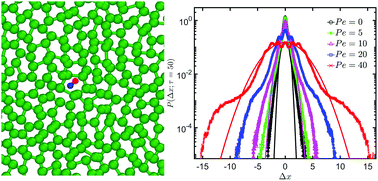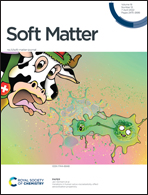Chemically symmetric and asymmetric self-driven rigid dumbbells in a 2D polymer gel†
Abstract
We employ computer simulations to unveil the translational and rotational dynamics of self-driven chemically symmetric and asymmetric rigid dumbbells in a two-dimensional polymer gel. Our results show that the activity or the self-propulsion always enhances the dynamics of the dumbbells. Making the self-propelled dumbbell chemically asymmetric leads to further enhancement in dynamics. Additionally, the direction of self-propulsion is a key factor for chemically asymmetric dumbbells, where self-propulsion towards the non-sticky half of the dumbbell results in faster translational and rotational dynamics compared to the case with the self-propulsion towards the sticky half of the dumbbell. Our analyses show that both the symmetric and asymmetric passive rigid dumbbells get trapped inside the mesh of the polymer gel, but the chemical asymmetry always facilitates the mesh to mesh motion of the dumbbell and it is even more pronounced when the dumbbell is self-propelled. This results in multiple peaks in the van Hove function with increasing self-propulsion. In a nutshell, we believe that our in silico study can guide researchers to design efficient artificial microswimmers possessing potential applications in site-specific delivery.



 Please wait while we load your content...
Please wait while we load your content...